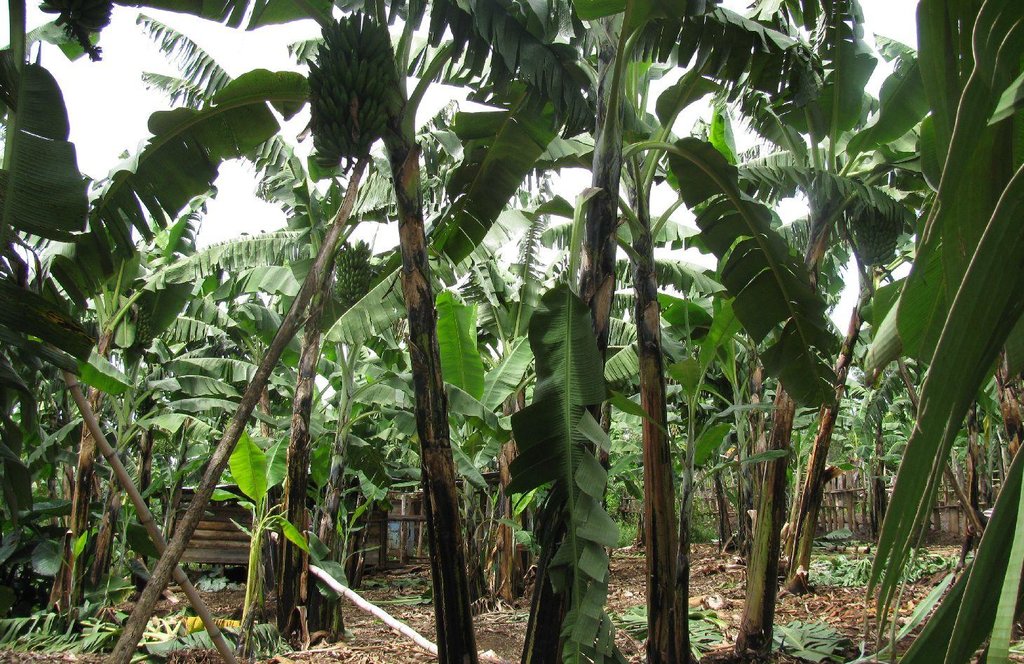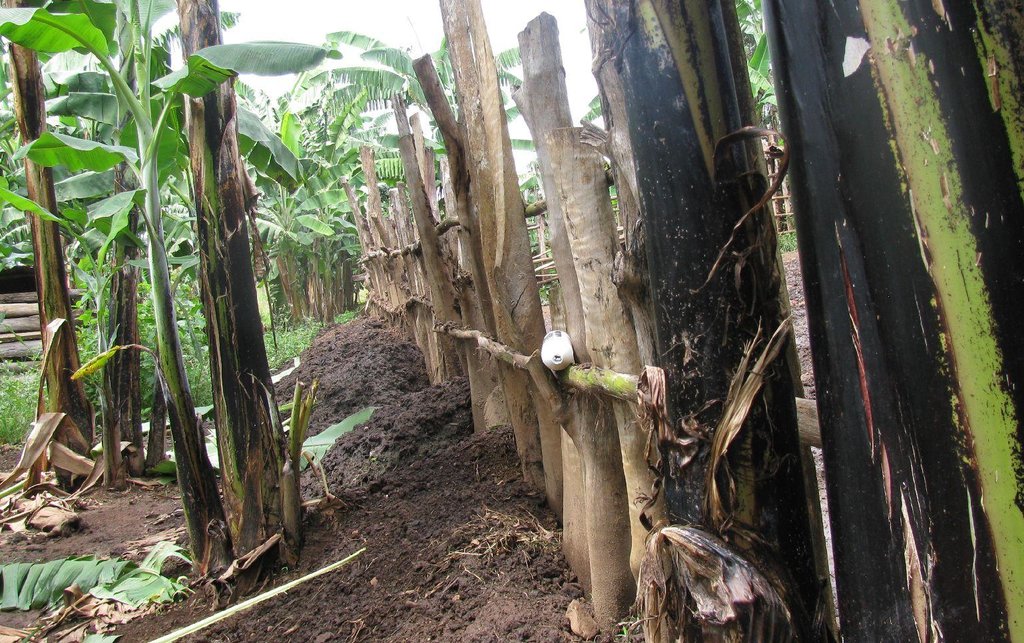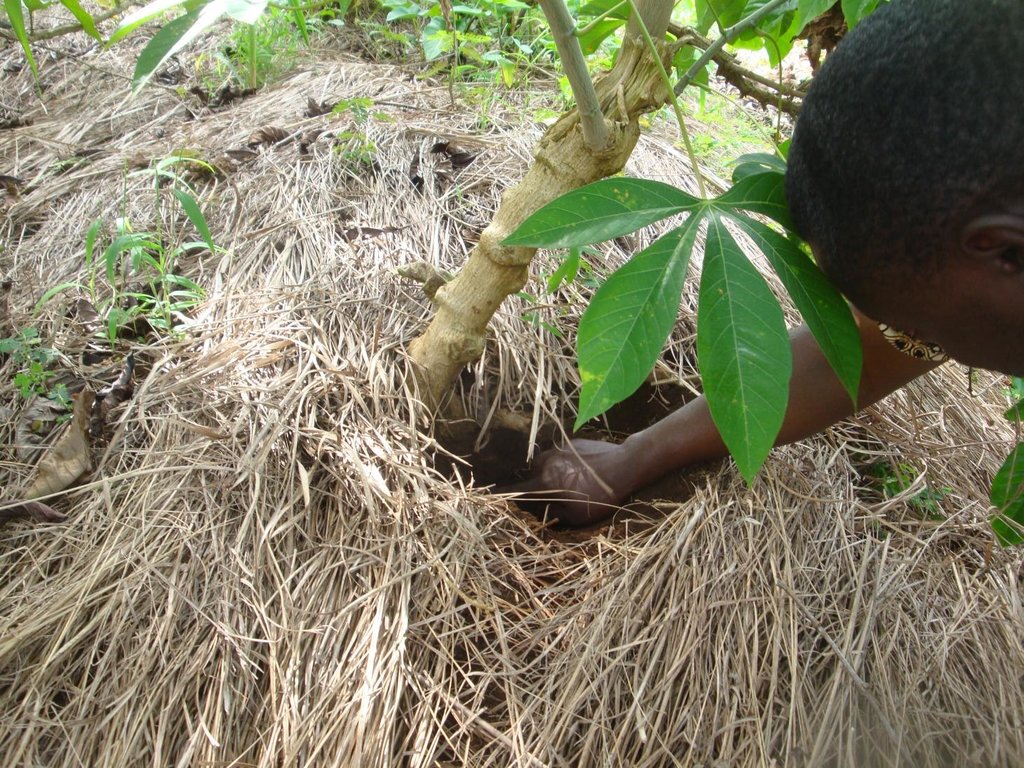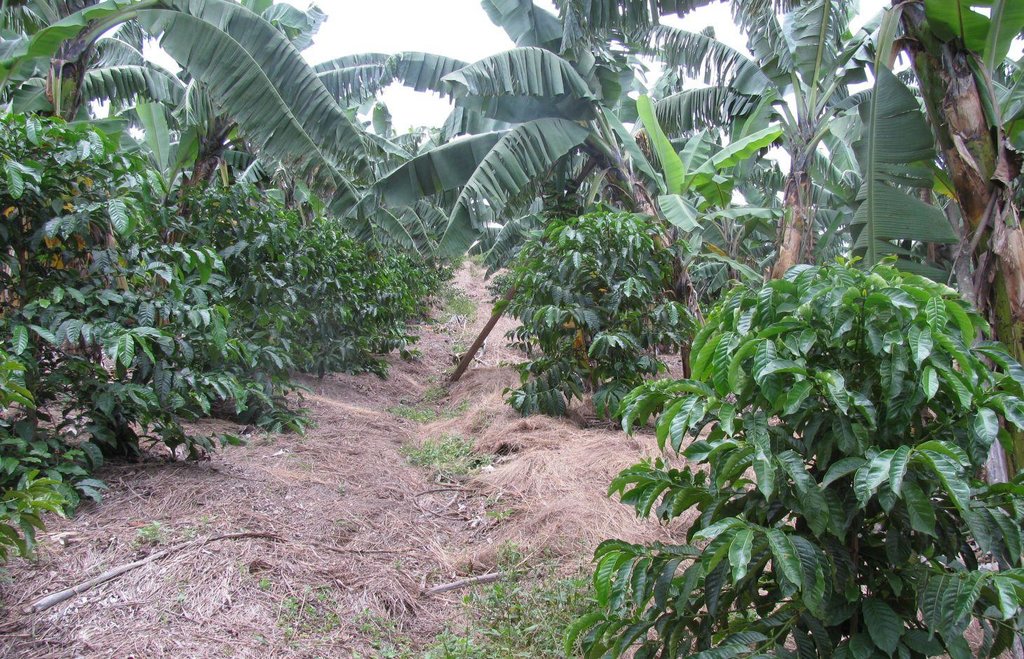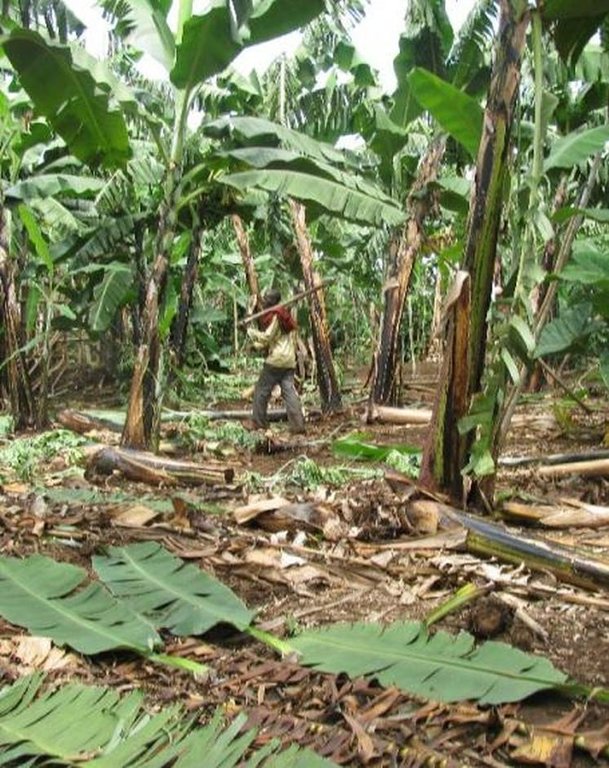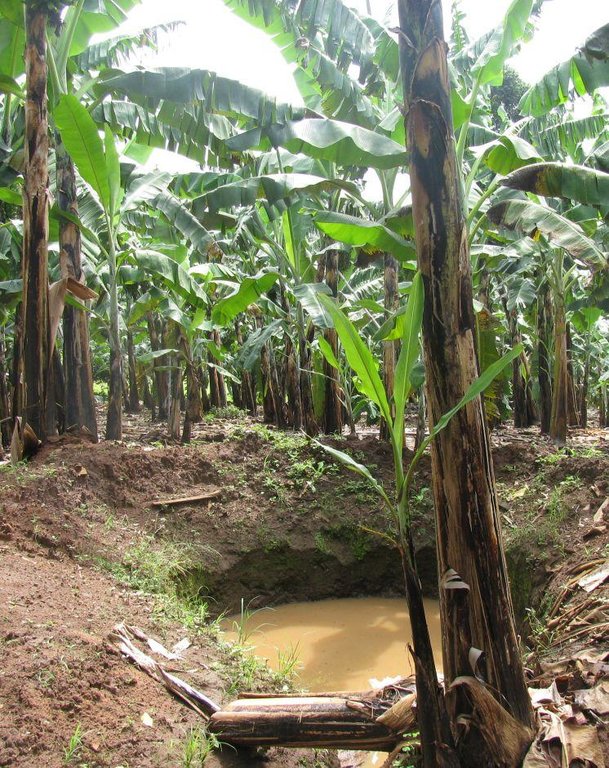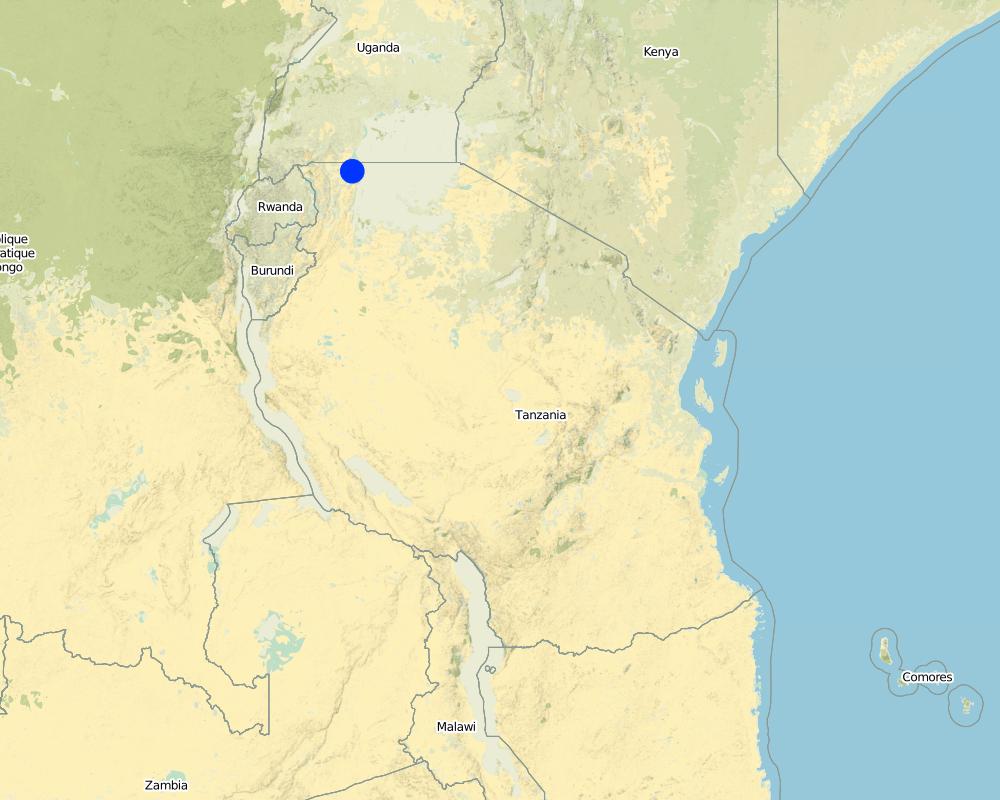Improved Kibanja cropping system [ຕານຊາເນຍ]
- ການສ້າງ:
- ປັບປູງ:
- ຜູ້ສັງລວມຂໍ້ມູນ: Jasson Rwazo
- ບັນນາທິການ: –
- ຜູ້ທົບທວນຄືນ: David Streiff
Ekibanja ekiine emikolele emirungi (Haya/Nyambo)
technologies_1183 - ຕານຊາເນຍ
ເບິ່ງພາກສ່ວນ
ຂະຫຍາຍທັງໝົດ ຍຸບທັງໝົດ1. ຂໍ້ມູນທົ່ວໄປ
1.2 ຂໍ້ມູນ ການຕິດຕໍ່ພົວພັນ ຂອງບຸກຄົນທີ່ສໍາຄັນ ແລະ ສະຖາບັນ ທີ່ມີສ່ວນຮ່ວມ ໃນການປະເມີນເອກກະສານ ເຕັກໂນໂລຢີ
Government:
ຜຸ້ຊ່ຽວຊານ ດ້ານການຄຸ້ມຄອງ ທີ່ດິນແບບຍືນຍົງ:
Government:
Makung'uto Iddi
Missenyi District Council
ຕານຊາເນຍ
Government:
Kagaruki Anna Grace
Missenyi District Council
ຕານຊາເນຍ
Government:
Subira John
Missenyi District Council
ຕານຊາເນຍ
ຜຸ້ຊ່ຽວຊານ ດ້ານການຄຸ້ມຄອງ ທີ່ດິນແບບຍືນຍົງ:
Kaihura Fidelis
+255 754273849
Fidelis.kaihura@fao.org
Kagera TAMP
P.O.Box 127 Bukoba
ຕານຊາເນຍ
Government:
Kitundu Elizabeth
Missenyi District Council
P.O.BOX 38 Missenyi
ຕານຊາເນຍ
ຊື່ສະຖາບັນ (ຫຼາຍສະຖາບັນ) ທີ່ອໍານວຍຄວາມສະດວກ ໃນການສ້າງເອກກະສານ / ປະເມີນ ເຕັກໂນໂລຢີ (ຖ້າກ່ຽວຂ້ອງ)
Food and Agriculture Organization of the United Nations (FAO) - ອີຕາລີຊື່ສະຖາບັນ (ຫຼາຍສະຖາບັນ) ທີ່ອໍານວຍຄວາມສະດວກ ໃນການສ້າງເອກກະສານ / ປະເມີນ ເຕັກໂນໂລຢີ (ຖ້າກ່ຽວຂ້ອງ)
Kagera Transboundary Agro-ecosystem Management (K-TAMP) - ຕານຊາເນຍຊື່ສະຖາບັນ (ຫຼາຍສະຖາບັນ) ທີ່ອໍານວຍຄວາມສະດວກ ໃນການສ້າງເອກກະສານ / ປະເມີນ ເຕັກໂນໂລຢີ (ຖ້າກ່ຽວຂ້ອງ)
Missenyi District Council (Missenyi District Council) - ຕານຊາເນຍ1.3 ເງື່ອນໄຂ ກ່ຽວກັບ ການນໍາໃຊ້ຂໍ້ມູນເອກະສານ ທີ່ສ້າງຂື້ນ ໂດຍຜ່ານ ອົງການພາບລວມຂອງໂລກ ທາງດ້ານແນວທາງ ແລະ ເຕັກໂນໂລຢີ ຂອງການອານຸລັກ ທໍາມະຊາດ (WOCAT)
ເມື່ອໃດທີ່ໄດ້ສັງລວມຂໍ້ມູນ (ຢູ່ພາກສະໜາມ)?
11/07/2012
ຜູ້ປ້ອນຂໍ້ມູນ ແລະ ບຸກຄົນສຳຄັນ ທີ່ໃຫ້ຂໍ້ມູນ (ຫຼາຍ) ຍິນຍອມ ຕາມເງື່ອນໄຂ ໃນການນຳໃຊ້ຂໍ້ມູນ ເພື່ອສ້າງເປັນເອກກະສານຂອງ WOCAT:
ແມ່ນ
2. ການອະທິບາຍ ເຕັກໂນໂລຢີ ຂອງການຄຸ້ມຄອງ ທີ່ດິນແບບຍືນຍົງ
2.1 ຄໍາອະທິບາຍສັ້ນຂອງ ເຕັກໂນໂລຢີ
ການກຳໜົດຄວາມໝາຍ ຂອງເຕັກໂນໂລຢີ:
This is a traditional banana and coffee complex cropping system interplanted with annual crops, trees,shrubs, vegetables and other diverse plants of social economic importance.
2.2 ການອະທິບາຍ ລາຍລະອຽດ ຂອງເຕັກໂນໂລຢີ
ການພັນລະນາ:
Improved traditional multi-cropping system that combines banana and coffee as main crops planted in a specific spacing to optimize plant stands. Banana and coffee are intercropped with; 1. annuals crops: Maize, beans, yams, coco-yams;2. Vegetables: Lycoperscum esculentum, Amaranthus spp, Cucumis communis and Solanum aethopium ;3. Shrubs of social economic value. Trees (e.g Maesopsis eminii, Makhcamia lutea, Ricinus comunis, Ficus thorninghii) and shrubs (Dracaena usambarensis) are planted on the farm edge. These serve as live fence, wind breaker, source of timber, fuel wood, medicine and protect the field against erosion. To optimize farm production, application of 15cm thick mulch ( grass mulch and banana prunnings), farmyard or compost manure and interplanting with soil fertility and/or soil moisture improvement trees are ensured. With problems of climate change, water harvesting ditches and trenches are constructed. Water harvesting ditches are constructed to collect water from micro catchments like roads or homestead. Sustainability of the Improved Kibanja system has always been assured through crop/livestock integration approaches.The cropping system is typical in high rainfall areas along foot slopes, valley bottoms or hilltops preferably on fertile and deep soils.
Purpose of the Technology: The purpose is improve soil fertility,moisture, controlling soil erosion (wind and water) and suppressing weeds in order to improve the production banana, coffee and other inter planted crops.
Establishment / maintenance activities and inputs: Establishment activities: 1. Land clearing and preparation: Slashing, uprooting tree stumps, ploughing and pitting 60cm x 90cm banana hole and 60cm x 60cm coffee (Mid June to August) using simple farm implements; 2.Farm Yard Manure application: 60 Kg per banana holes and 36 Kg per coffee hole (August to early September); 2. Planting: 308 banana suckers at 3.6m x 8m spacing, 830 coffee seedlings at 3m x 8m spacing in alternating row, edge row trees seedling at 10m spacing and 15cm spacing for shrubs e.g. Dracaena usambarensis (September to November);4. Excavation of water retention structure ( after planting mainly in Novermber). Full establishment of Improved Kibanja cropping system can be attained in three years.
Maintenance activities:1. Weeding:Done two times per year (mid January to February / July to augost) before planting annual crops; 2.FYM enrichment: Every after 3 years; iii. banana dethrashing and desuckering ,topping mulch, coffee pruning and harvesting (Immediately after weeding); 4. Other maintenence activities: Disease control (nematode, banana weevils, Banana Xanthamonas Wilt) and Propping (using pole to support banana plant with heavy bunches against wind); 5.Inputs: Labour, farmyard manure, propping poles, mulch; 6. Simple farm implements:Hand hoe,machete and wheel barrow.
Natural / human environment: The technology is implemented in mixed land use type under sub humid condition receiving 1000-1500mm of rains per year. A combination of soil and water improvement measures (FYM application, Mulching, water retention ditches and live fencing) complement each other to minimize risk of crop failure and hence improve production. The slope is gentle to moderate , soil depth is moderate and soil texture loam. Simple hand tools are traditional used,Land ownership is individual not titled. Application of this technology determined by high establishment and maintenence cost.
2.3 ຮູບພາບຂອງເຕັກໂນໂລຢີ
2.5 ປະເທດ / ເຂດ / ສະຖານທີ່ບ່ອນທີ່ ເຕັກໂນໂລຢີ ໄດ້ຮັບການນໍາໃຊ້ ແລະ ທີ່ຖືກປົກຄຸມດ້ວຍການປະເມີນຜົນ
ປະເທດ:
ຕານຊາເນຍ
ພາກພື້ນ / ລັດ / ແຂວງ:
Tanzania
ຂໍ້ມູນເພີ່ມເຕີມຂອງສະຖານທີ່:
Missenyi District, Kyazi Village
Map
×2.6 ວັນທີໃນການຈັດຕັ້ງປະຕິບັດ
ຖ້າຫາກວ່າ ບໍ່ຮູ້ຈັກ ປີທີ່ຊັດເຈນ ແມ່ນໃຫ້ປະມານ ວັນທີເອົາ:
- ຕໍ່າກວ່າ 10 ປີ ຜ່ານມາ (ມາເຖິງປະຈຸບັນ)
2.7 ການນໍາສະເໜີ ເຕັກໂນໂລຢີ
ໃຫ້ລະບຸ ເຕັກໂນໂລຢີ ໄດ້ຖືກຈັດຕັ້ງປະຕິບັດຄືແນວໃດ?
- ໂດຍຜ່ານໂຄງການ / ການຊ່ວຍເຫຼືອຈາກພາຍນອກ
ຄວາມຄິດເຫັນ (ປະເພດ ໂຄງການ ແລະ ອື່ນໆ):
Improved traditional land use system: The use of combination of measures in Improved Kibanja Cropping system in Kagera has been existing for more than 100 year ago.
3. ການໃຈ້ແຍກ ເຕັກໂນໂລຢີ ໃນການຄຸ້ມຄອງ ດິນແບບຍືນຍົງ
3.1 ຈຸດປະສົງຫຼັກ (ຫຼາຍ) ຂອງເຕັກໂນໂລຢີ
- ປັບປຸງ ການຜະລິດ
- ຫຼຸດຜ່ອນ, ປ້ອງກັນ, ຟື້ນຟູ ການເຊື່ອມໂຊມຂອງດິນ
- improve soil fertility
3.2 ປະເພດການນໍາໃຊ້ທີ່ດິນ ໃນປະຈຸບັນ() ທີ່ເຕັກໂນໂລຢີ ໄດ້ຖືກນໍາໃຊ້

ປະສົມປະສານ (ການປູກພືດ / ທົ່ງຫຍ້າລ້ຽງສັດ / ຕົ້ນໄມ້), ລວມທັງ ປ່າໄມ້ ແບບປະສົມປະສານ
- ປ່າໄມ້-ທົ່ງຫຍ້າ
ຜະລິດຕະພັນຫຼັກ / ບໍລິການ:
Ficus thoninji,Markhamia lutea,Maesopesis eminii
major cash crop: Beans, banana and avocado
major food crop: Beans and banana
ຄວາມຄິດເຫັນ:
Major land use problems (compiler’s opinion): Soil nutrient loss, decline of soil moisture and soil erosion by wind and fast water runoff.
Major land use problems (land users’ perception): Reduced crop production, loss of indigenous medicinal plants, reduced water water quatity in natural water sources.
Type of cropping system and major crops comments: Due to mixed farming and agroforestry there is high nutrient cycling resulting in high productivity
3.3 ຂໍ້ມູນເພີ່ມເຕີມກ່ຽວກັບການນໍາໃຊ້ທີ່ດິນ
ການສະໜອງນໍ້າ ໃນພື້ນທີ່ ທີ່ໄດ້ນໍາໃຊ້ ເຕັກໂນໂລຢີ:
- ນໍ້າຝົນ
ຈໍານວນ ລະດູການ ປູກໃນປີໜຶ່ງ:
- 2
ລະບຸ ຊະນິດ:
Longest growing period in days: 120; Longest growing period from month to month: Short rains (September to December); Second longest growing period in days: 65; Second longest growing period from month to month: Long rains (March to June)
ຄວາມໜາແໜ້ນ ຂອງສັດລ້ຽງ (ຖ້າຫາກວ່າກ່ຽວຂ້ອງ):
1-10 LU /km2
3.4 ການນໍາໃຊ້ເຕັກໂນໂລຢີ ທີ່ຢູ່ໃນກຸ່ມການຄຸ້ມຄອງ ທີ່ດິນແບບຍືນຍົງ
- ກະສິກໍາ-ປ່າໄມ້ ແບບປະສົມປະສານ
- ແລວກັນລົມ / ພາຍຸ
- ການເກັບກັກນໍ້າ
3.5 ການຂະຫຍາຍເຕັກໂນໂລຢີ
ໃຫ້ລະບຸ ການແຜ່ຂະຫຍາຍ ເຕັກໂນໂລຢີ:
- ແຜ່ຂະຫຍາຍຢ່າງໄວວາໃນພື້ນທີ່
ຖ້າຫາກວ່າ ເຕັກໂນໂລຢີ ໄດ້ແຜ່ຂະຫຍາຍທົ່ວພື້ນທີ່ືື ຢ່າງສະໜ່ຳສະເໝີ, ໃຫ້ລະບຸ ເນື້ອທີ່ ໂດຍການຄາດຄະເນ:
- < 0.1 ກິໂລແມັດ2 (10 ເຮັກຕາ)
ຄວາມຄິດເຫັນ:
Total area covered by the SLM Technology is 0.062 km2.
2ha approximately
3.6 ມາດຕະການ ການຄຸ້ມຄອງ ທີ່ດິນແບບຍືນຍົງ ປະກອບດ້ວຍ ເຕັກໂນໂລຢີ

ມາດຕະການ ທາງການກະສິກໍາ
- A2: ອິນຊີວັດຖຸ ຫຼື ຄວາມອຸດົມສົມບູນໃນດິນ

ມາດຕະການ ທາງດ້ານພືດພັນ
- V1: ເປັນໄມ້ຢືນຕົ້ນ ແລະ ການປົກຫຸ້ມຂອງໄມ້ພຸ່ມ
- V2: ຫຍ້າ ແລະ ພືດສະໝູນໄພທີ່ເປັນໄມ້ຢືນຕົ້ນ

ມາດຕະການໂຄງສ້າງ
- S4: ລະດັບຮ່ອງ, ຂຸມ

ມາດຕະການ ທາງດ້ານການຄຸ້ມຄອງ
- M3: ອີງຕາມສະພາບແວດລ້ອມ ທາງທຳມະຊາດ ແລະ ມະນຸດ
ຄວາມຄິດເຫັນ:
Secondary measures: management measures
Type of agronomic measures: mixed cropping / intercropping, retaining more vegetation cover, mulching, manure / compost / residues, minimum tillage, pits
Type of vegetative measures: aligned: -against wind, aligned: -along boundary, aligned: -linear
3.7 ປະເພດດິນເຊື່ອມໂຊມ ຫຼັກທີ່ໄດ້ນໍາໃຊ້ ເຕັກໂນໂລຢີ

ດິນເຊາະເຈື່ອນ ໂດຍນໍ້າ
- Wt: ການສູນເສຍຊັ້ນໜ້າດິນ / ການເຊາະເຈື່ອນຜິວໜ້າດິນ

ການເຊື່ອມໂຊມ ຂອງດິນ ທາງເຄມີ
- Cn: ຄວາມອຸດົມສົມບູນ ລົດໜ້ອຍຖອຍລົງ ແລະ ສານອິນຊີວັດຖຸລົດລົງ (ບໍ່ແມ່ນສາເຫດມາຈາກການເຊາະເຈື່ອນ)

ການເຊື່ອມໂຊມ ທາງຊີວະພາບ
- Bc: ການຫຼຸດຜ່ອນການປົກຫຸ້ມຂອງພືດ
ຄວາມຄິດເຫັນ:
Main causes of degradation: soil management (Cultivation along the slope and overcultivation), crop management (annual, perennial, tree/shrub) (Cultivation of season crop without reprenishing of soil nutrients), change of seasonal rainfall (Fractuation in rain season), droughts, population pressure, education, access to knowledge and support services
Secondary causes of degradation: Heavy / extreme rainfall (intensity/amounts), land tenure, poverty / wealth, inputs and infrastructure: (roads, markets, distribution of water points, other, …)
3.8 ການປ້ອງກັນ, ການຫຼຸດຜ່ອນ, ຫຼືການຟື້ນຟູຂອງການເຊື່ອມໂຊມຂອງດິນ
ໃຫ້ລະບຸ ເປົ້າໝາຍ ເຕັກໂນໂລຢີ ທີ່ພົວພັນ ກັບຄວາມເຊື່ອມໂຊມຂອງດິນ:
- ປ້ອງກັນການເຊື່ອມໂຊມຂອງດິນ
- ຫຼຸດຜ່ອນການເຊື່ອມໂຊມຂອງດິນ
ຄວາມຄິດເຫັນ:
Secondary goals: mitigation / reduction of land degradation
4. ຂໍ້ກໍາໜົດ, ກິດຈະກໍາການປະຕິບັດ, ວັດຖຸດິບ, ແລະຄ່າໃຊ້ຈ່າຍ
4.1 ເຕັກນິກ ໃນການແຕ້ມແຜນວາດ ເຕັກໂນໂລຢີ
ຜູ້ຂຽນ:
Jasson Rwazo, P.O.BOX 38 Misseny Tanzania, rjrwazo@gmail.com
4.2 ການແຕ້ມແຜນວາດອະທິບາຍເຕັກນິກ
Location: Kyazi Village. Missenyi District, Kagera Region, Tanzania
Date: 2012.08.28
Technical knowledge required for field staff / advisors: moderate (The technology requires moderate technical knowledge for adoption)
Technical knowledge required for land users: moderate (The technology requires moderate technical knowledge for adoption)
Main technical functions: control of raindrop splash, control of dispersed runoff: retain / trap, control of concentrated runoff: retain / trap, improvement of ground cover, increase in organic matter
Secondary technical functions: increase in nutrient availability (supply, recycling,…), increase of infiltration, water harvesting / increase water supply, reduction in wind speed, increase of biomass (quantity)
Mixed cropping / intercropping
Material/ species: Banana
Quantity/ density: 304
Remarks: 3.6 m by 8m
Retaining more vegetation cover
Material/ species: Beans
Remarks: Random
Mulching
Material/ species: Grass mulch, banana(Prooning) trashes mulch
Quantity/ density: 10000
Remarks: Spreading the mulch
Material/ species: Coffee
Quantity/ density: 830
Remarks: 3m by 8m
Manure / compost / residues
Material/ species: Farmyard manure, farm residure,
Quantity/ density: 40 tone
Remarks: Spreading on the pit
Minimum tillage
Material/ species: Hand hoe,matechette
Pits
Material/ species: Hand hoe,matechette
Aligned: -against wind
Vegetative material: T : trees / shrubs
Number of plants per (ha): 277
Vertical interval between rows / strips / blocks (m): Random
Spacing between rows / strips / blocks (m): Random
Vertical interval within rows / strips / blocks (m): Random
Width within rows / strips / blocks (m): 6
Aligned: -along boundary
Vegetative material: T : trees / shrubs
Number of plants per (ha): 100000
Vertical interval between rows / strips / blocks (m): 0.01
Width within rows / strips / blocks (m): 0.01
Aligned: -linear
Vegetative material: T : trees / shrubs
Number of plants per (ha): 100000
Vertical interval between rows / strips / blocks (m): 0.01
Width within rows / strips / blocks (m): 0.01
Trees/ shrubs species: Maeesopsis Eminii, Dracaena usambalensis,Erythrina abysinica
Fruit trees / shrubs species: Pawpaw, Orange, Avocado
Perennial crops species: Banana, Coffee, Vanilla
Other species: Carisa edulis (shrubs)
Slope (which determines the spacing indicated above): 6.3%
Gradient along the rows / strips: 6.3%
Diversion ditch/ drainage
Vertical interval between structures (m): 0.4
Spacing between structures (m): 6
Depth of ditches/pits/dams (m): 0.3
Width of ditches/pits/dams (m): 0.3
Length of ditches/pits/dams (m): 3
Height of bunds/banks/others (m): 0.15
Width of bunds/banks/others (m): 0.15
Length of bunds/banks/others (m): 3
Waterway
Vertical interval between structures (m): 0.4
Spacing between structures (m): 6
Depth of ditches/pits/dams (m): 0.75
Width of ditches/pits/dams (m): 1.5
Length of ditches/pits/dams (m): 2
Height of bunds/banks/others (m): 0.3
Width of bunds/banks/others (m): 0.4
Length of bunds/banks/others (m): 5
Retention/infiltration ditch/pit, sediment/sand trap
Vertical interval between structures (m): 0.4
Spacing between structures (m): 6
Depth of ditches/pits/dams (m): 0.75
Width of ditches/pits/dams (m): 1.5
Length of ditches/pits/dams (m): 2
Height of bunds/banks/others (m): 0.3
Width of bunds/banks/others (m): 0.4
Length of bunds/banks/others (m): 5
Construction material (earth): 2.25 m3 of earth material used per ditch
Slope (which determines the spacing indicated above): 6%
Lateral gradient along the structure: 8%
Specification of dams/ pans/ ponds: Capacity 10m3
Catchment area: 1.6Ham2
For water harvesting: the ratio between the area where the harvested water is applied and the total area from which water is collected is: 1:3.5
4.3 ຂໍ້ມູນທົ່ວໄປກ່ຽວກັບການຄິດໄລ່ປັດໃຈຂາເຂົ້າໃນການຜະລິດ ແລະ ມູນຄ່າອື່ນໆ
ລະບຸ ສະກຸນເງິນທີ່ໃຊ້ສໍາລັບ ການຄິດໄລ່ຄ່າໃຊ້ຈ່າຍ:
- ໂດລາສະຫະລັດ
ລະບຸ ຄ່າຈ້າງ ຄ່າແຮງງານສະເລ່ຍ ຕໍ່ ວັນ:
1
4.4 ການສ້າງຕັ້ງກິດຈະກໍາ
| ກິດຈະກໍາ | ປະເພດ ມາດຕະການ | ໄລຍະເວລາ | |
|---|---|---|---|
| 1. | Land clearing and preparation:Slashing,uprooting tree stumps, ploughing and pitting | June to August | |
| 2. | Availing and applying 54 tone Farm Yard | August to early September | |
| 3. | Planting: 308 banana suckers 830 coffee and tree edge low tree seedlings | From September | |
| 4. | Construction of water harvesting ditches | ໂຄງສ້າງ | Once year |
4.5 ຕົ້ນທຶນ ແລະ ປັດໄຈຂາເຂົ້າທີ່ຈໍາເປັນໃນຈັດຕັ້ງປະຕິບັດ
| ລະບຸ ປັດໃຈ ນໍາເຂົ້າ ໃນການຜະລີດ | ຫົວໜ່ວຍ | ປະລິມານ | ຕົ້ນທຶນ ຕໍ່ຫົວໜ່ວຍ | ຕົ້ນທຶນທັງໝົດ ຂອງປັດໃຈຂາເຂົ້າ ໃນການຜະລິດ | % ຂອງຕົ້ນທຶນທັງໝົດ ທີ່ຜູ້ນໍາໃຊ້ທີ່ດິນ ໃຊ້ຈ່າຍເອງ | |
|---|---|---|---|---|---|---|
| ແຮງງານ | Land clearing | persons/day | 202.0 | 1.18316 | 239.0 | 100.0 |
| ແຮງງານ | Construction of water harvesting ditches | persons/day | 4.0 | 0.937 | 3.75 | 100.0 |
| ອຸປະກອນ | Tools | ha | 1.0 | 61.56 | 61.56 | 100.0 |
| ວັດສະດຸໃນການປູກ | Seedlings | pieces | 1138.0 | 0.0468 | 53.26 | 100.0 |
| ຝຸ່ນ ແລະ ຢາຊີວະພາບ | Manure | tons | 54.0 | 34.7222 | 1875.0 | |
| ອື່ນໆ | Cuttings | ha | 1.0 | 2234.6 | 2234.6 | 100.0 |
| ຕົ້ນທຶນທັງໝົດ ໃນການຈັດຕັ້ງປະຕິບັດ ເຕັກໂນໂລຢີ | 4467.17 | |||||
ຄວາມຄິດເຫັນ:
Duration of establishment phase: 36 month(s)
4.6 ບໍາລຸງຮັກສາ / ແຜນຈັດຕັ້ງປະຕິບັດ ກິດຈະກໍາ
| ກິດຈະກໍາ | ປະເພດ ມາດຕະການ | ໄລຍະເວລາ / ຄວາມຖີ່ | |
|---|---|---|---|
| 1. | Topping grass mulch | ພືດ | 3 times per year |
| 2. | Farm yard manure enrichment | ພືດ | 2 times per year |
| 3. | Removal of sediments and debris in water retention ditches. | ພືດ | Every year |
| 4. | To replacement propping Poles | ພືດ | Every 1.5 year |
| 5. | To corve transportation cost | ພືດ | Manure |
| 6. | Replacement of propping pole and live hedges | ການບໍາລຸງລ້ຽງ | Every 1.5 year |
| 7. | Removal of sediments and debris in water retention ditches | ໂຄງສ້າງ | Once per year |
4.7 ຄ່າໃຊ້ຈ່າຍ ແລະ ປັດໄຈນໍາເຂົ້າທີ່ຈໍາເປັນສໍາລັບການບໍາລຸງຮັກສາກິດຈະກໍາ / ແຜນປະຕິບັດ (ຕໍ່ປີ)
| ລະບຸ ປັດໃຈ ນໍາເຂົ້າ ໃນການຜະລີດ | ຫົວໜ່ວຍ | ປະລິມານ | ຕົ້ນທຶນ ຕໍ່ຫົວໜ່ວຍ | ຕົ້ນທຶນທັງໝົດ ຂອງປັດໃຈຂາເຂົ້າ ໃນການຜະລິດ | % ຂອງຕົ້ນທຶນທັງໝົດ ທີ່ຜູ້ນໍາໃຊ້ທີ່ດິນ ໃຊ້ຈ່າຍເອງ | |
|---|---|---|---|---|---|---|
| ແຮງງານ | Topping grass mulch | persons/day | 10.0 | 4.101 | 41.01 | 100.0 |
| ແຮງງານ | Applying FYM | persons/day | 10.0 | 3.906 | 39.06 | 100.0 |
| ແຮງງານ | Removal of sediments | persons/day | 4.0 | 0.9375 | 3.75 | 100.0 |
| ແຮງງານ | To replacement propping Poles | persons/day/ha | 10.0 | 3.906 | 39.06 | 100.0 |
| ອຸປະກອນ | Tools | per ha | 4.0 | 1.875 | 7.5 | 100.0 |
| ຝຸ່ນ ແລະ ຢາຊີວະພາບ | Farm yard manure | tons | 20.833 | 46.8 | 974.98 | 100.0 |
| ວັດສະດຸກໍ່ສ້າງ | Wood | pieces/ha | 600.0 | 0.625 | 375.0 | 100.0 |
| ອື່ນໆ | Mulching material | bundle | 300.0 | 1.875 | 562.5 | 100.0 |
| ອື່ນໆ | Transportation | trips | 19.0 | 61.673 | 1171.79 | 100.0 |
| ຕົ້ນທຶນທັງໝົດ ທີ່ໃຊ້ໃນການບໍາລຸງຮັກສາ ເຕັກໂນໂລຢີ | 3214.65 | |||||
ຄວາມຄິດເຫັນ:
Machinery/ tools: Machetes, Mattocks, Hand hoe, spade, wheel barrow, Machete,Hand hoes, spade, Hand hoe,Machete, Spade
Cost assesment completed in June 2012
4.8 ປັດໄຈ ທີ່ສໍາຄັນ ທີ່ສົ່ງຜົນກະທົບ ຕໍ່ຄ່າໃຊ້ຈ່າຍ
ໃຫ້ອະທິບາຍ ປັດໃຈ ທີ່ສົ່ງຜົນກະທົບ ຕໍ່ຕົ້ນທຶນ ໃນການຈັດຕັ້ງປະຕິບັດ:
Manure is most determinate factor high transportation cost especially during establishment
5. ສະພາບແວດລ້ອມທໍາມະຊາດ ແລະ ມະນຸດ
5.1 ອາກາດ
ປະລິມານນໍ້າຝົນປະຈໍາປີ
- < 250 ມີລິແມັດ
- 251-500 ມີລິແມັດ
- 501-750 ມີລິແມັດ
- 751-1,000 ມີລິແມັດ
- 1,001-1,500 ມີລິແມັດ
- 1,501-2,000 ມີລິແມັດ
- 2,001-3,000 ມີລິແມັດ
- 3,001-4,000 ມີລິແມັດ
- > 4,000 ມີລິແມັດ
ຂໍ້ມູນສະເພາະ / ຄວາມເຫັນກ່ຽວກັບ ປະລິມານນໍ້າຝົນ:
Avarage rainfall 1200mm, Bimode rainfall, 5 month dry season
ເຂດສະພາບອາກາດກະສິກໍາ
- ເຄີ່ງຄວາມຊຸ່ມ
Thermal climate class: tropics. Annual temperature 23C
Length of growing period 120 -300 days
5.2 ພູມິປະເທດ
ຄ່າສະເລ່ຍ ຄວາມຄ້ອຍຊັນ:
- ພື້ນທີ່ຮາບພຽງ (0-2%)
- ອ່ອນ (3-5 %)
- ປານກາງ (6-10 %)
- ມ້ວນ (11-15 %)
- ເນີນ(16-30%)
- ໍຊັນ (31-60%)
- ຊັນຫຼາຍ (>60%)
ຮູບແບບຂອງດິນ:
- ພູພຽງ / ທົ່ງພຽງ
- ສັນພູ
- ເປີ້ນພູ
- ເນີນພູ
- ຕີນພູ
- ຮ່ອມພູ
ເຂດລະດັບສູງ:
- 0-100 ແມັດ a.s.l.
- 101-500 ແມັດ a.s.l.
- 501-1,000 ແມັດ a.s.l.
- 1,001-1,500 ແມັດ a.s.l.
- 1,501-2,000 ແມັດ a.s.l.
- 2,001-2,500 ແມັດ a.s.l.
- 2,501-3,000 ແມັດ a.s.l.
- 3,001-4,000 ແມັດ a.s.l.
- > 4,000 ແມັດ a.s.l.
ໃຫ້ລະບຸ ເຕັກໂນໂລຢີ ທີ່ໄດ້ຖືກນຳໃຊ້:
- ລັກສະນະກີ່ວ
ຄຳເຫັນ ແລະ ຂໍ້ມູນສະເພາະ ເພີ່ມເຕີມ ກ່ຽວກັບ ພູມີປະເທດ:
Altitudinal zonation: 1270m a.s.l
Slopes on average: Movement of soil due to erosion, exposure of parent rock on some part of the farm
5.3 ດິນ
ຄວາມເລິກ ຂອງດິນສະເລ່ຍ:
- ຕື້ນຫຼາຍ (0-20 ຊັງຕີແມັດ)
- ຕື້ນ (21-50 ຊຕມ)
- ເລີກປານກາງ (51-80 ຊຕມ)
- ເລິກ (81-120 ຊມ)
- ເລິກຫຼາຍ (> 120 cm)
ເນື້ອດິນ (ໜ້າດິນ):
- ປານກາງ (ດິນໜຽວ, ດິນໂຄນ)
ຊັ້ນອິນຊີວັດຖຸ ເທິງໜ້າດິນ:
- ປານກາງ (1-3 %)
ຖ້າເປັນໄປໄດ້ ແມ່ນໃຫ້ຕິດຄັດ ການພັນລະນາດິນ ຫຼື ຂໍ້ມູນສະເພາະຂອງດິນ, ຕົວຢ່າງ, ຄຸນລັກສະນະ ປະເພດຂອງດິນ, ຄ່າຄວາມເປັນກົດ / ເປັນດ່າງຂອງດິນ, ສານອາຫານ, ດິນເຄັມ ແລະ ອື່ນໆ.
Soil depth on average: Shallow on the hill slope and moderately deep on the valley bottom, also deep sometimes
Soil texture (topsoil): Sandy loam
Topsoil organic matter: Due to the high use of organic manure (farm yard manure) and mulch
Soil fertility is medium
Soil drainage / infiltration is medium due to the high use of organic manure (farm yard manure), mulch, good aeration
Soil water storage capacity is medium due to the high use of organic manure (farm yard manure) and mulch
5.4 ມີນໍ້າ ແລະ ຄຸນນະພາບ
ລະດັບ ນໍ້າໃຕ້ດິນ:
> 50 ແມັດ
ການມີນໍ້າ ເທິງໜ້າດິນ:
ປານກາງ
ຄຸນນະພາບນໍ້າ (ບໍ່ມີການບໍາບັດ):
ບໍ່ມີນໍ້າດື່ມ (ຮຽກຮ້ອງໃຫ້ມີການບຳບັດນ້ຳ)
5.5 ຊີວະນາໆພັນ
ຄວາມຫຼາກຫຼາຍ ທາງສາຍພັນ:
- ປານກາງ
ຄວາມຄິດເຫັນ ແລະ ລັກສະນະສະເພາະ ເພີ່ມເຕີມກ່ຽວກັບ ຊີວະນາໆພັນ:
Different species of soil micro organisms and plant species
5.6 ຄຸນລັກສະນະ ຂອງຜູ້ນໍາໃຊ້ທີ່ດິນ ທີ່ໄດ້ນໍາໃຊ້ເຕັກໂນໂລຢີ
ລະບົບ ການຕະຫຼາດ ແລະ ຜົນຜະລິດ:
- ປະສົມ (ກຸ້ມຕົນເອງ / ເປັນສິນຄ້າ
ລາຍຮັບ ທີ່ບໍ່ໄດ້ມາຈາກ ການຜະລິດ ກະສິກໍາ:
- ໜ້ອຍກ່ວາ 10 % ຂອງລາຍຮັບທັງໝົດ
ລະດັບຄວາມຮັ່ງມີ:
- ສະເລ່ຍ
ບຸກຄົນ ຫຼື ກຸ່ມ:
- ບຸກຄົນ / ຄົວເຮືອນ
ລະດັບ ການຫັນເປັນກົນຈັກ:
- ການໃຊ້ແຮງງານຄົນ
ເພດ:
- ຜູ້ຍິງ
- ຜູ້ຊາຍ
ໃຫ້ລະບຸ ຄຸນລັກສະນະ ຂອງຜູ້ນໍາໃຊ້ທີ່ດິນ:
Land users applying the Technology are mainly common / average land users
Difference in the involvement of women and men: The land inheritance is mainly dominated by male, women mostly use the land for production of understory crops such as beans; banana and coffee production is dominated by men
Population density: > 500 persons/km2
Annual population growth: 2% - 3%; 3%
5% of the land users are very rich and own 30% of the land (Own 2.5-5 acre land, car, 10-20 catlle,brick wall house).
15% of the land users are rich and own 20% of the land (Own 1-2.5 acre of land,2-5 cattle, brick wall house).
60% of the land users are average wealthy and own 35% of the land (Own 0.5-1 acre of land,2-3 goats,mud wall house with corrugarated iron roof).
15% of the land users are poor and own 10% of the land (Own 0-0.5 acre of land, no livestock, mud house withgrass roofing).
5% of the land users are poor and own 5% of the land (Does not own land or own less than 0.5 acre of land, work as casual labour).
Off-farm income specification: 90% of land users income depends on on- income
Market orientation of production system: Mainly for substence for commecial
Level of mechanization: Using hand tools
5.7 ພື້ນທີ່ສະເລ່ຍຂອງທີ່ດິນ ຫຼື ເຊົ່າໂດຍຜູ້ໃຊ້ທີ່ດິນການນໍາໃຊ້ ເຕັກໂນໂລຢີ
- <0.5 ເຮັກຕາ
- 0.5-1 ເຮັກຕາ
- 1-2 ເຮັກຕາ
- 2-5 ເຮັກຕາ
- 5-15 ເຮັກຕາ
- 15-50 ເຮັກຕາ
- 50-100 ເຮັກຕາ
- 100-500 ເຮັກຕາ
- 500-1,000 ເຮັກຕາ
- 1,000-10,000 ເຮັກຕາ
- > 10,000 ເຮັກຕາ
5.8 ເຈົ້າຂອງທີ່ດິນ, ສິດໃຊ້ທີ່ດິນ, ແລະ ສິດທິການນໍາໃຊ້ນໍ້າ
ເຈົ້າຂອງດິນ:
- ບຸກຄົນ, ບໍ່ມີຕໍາແໜ່ງ
5.9 ການເຂົ້າເຖິງການບໍລິການ ແລະ ພື້ນຖານໂຄງລ່າງ
ສຸຂະພາບ:
- ທຸກຍາກ
- ປານກາງ
- ດີ
ການສຶກສາ:
- ທຸກຍາກ
- ປານກາງ
- ດີ
ການຊ່ວຍເຫຼືອ ດ້ານວິຊາການ:
- ທຸກຍາກ
- ປານກາງ
- ດີ
ການຈ້າງງານ (ຕົວຢ່າງ, ການເຮັດກິດຈະກໍາອື່ນ ທີ່ບໍ່ແມ່ນ ການຜະລິດກະສິກໍາ):
- ທຸກຍາກ
- ປານກາງ
- ດີ
ຕະຫຼາດ:
- ທຸກຍາກ
- ປານກາງ
- ດີ
ພະລັງງານ:
- ທຸກຍາກ
- ປານກາງ
- ດີ
ຖະໜົນຫົນທາງ ແລະ ການຂົນສົ່ງ:
- ທຸກຍາກ
- ປານກາງ
- ດີ
ການດື່ມນໍ້າ ແລະ ສຸຂາພິບານ:
- ທຸກຍາກ
- ປານກາງ
- ດີ
ການບໍລິການ ທາງດ້ານການເງິນ:
- ທຸກຍາກ
- ປານກາງ
- ດີ
6. ຜົນກະທົບ ແລະ ລາຍງານສະຫຼຸບ
6.1 ການສະແດງຜົນກະທົບ ພາຍໃນພື້ນທີ່ ທີ່ໄດ້ຈັດຕັ້ງປະຕິບັດ ເຕັກໂນໂລຢີ
ຜົນກະທົບທາງເສດຖະກິດສັງຄົມ
ການຜະລິດ
ການຜະລິດພືດ
ປະລິມານ ກ່ອນການຈັດຕັ້ງປະຕິບັດ ການຄຸ້ມຄອງ ທີ່ດິນແບບຍືນຍົງ:
50
ປະລີມານ ຫຼັງການຈັດຕັ້ງປະຕິບັດ ການຄຸ້ມຄອງ ທີ່ດິນແບບຍືນຍົງ:
300
ຄວາມຄິດເຫັນ / ລະບຸແຈ້ງ:
Bunch of banana with 70 kg each
ຄວາມສ່ຽງ ຕໍ່ຜົນຜະລິດ
ຄວາມໜາແໜ້ນ ຂອງຜົນຜະລິດ
ຄວາມຄິດເຫັນ / ລະບຸແຈ້ງ:
Depend mainly on banana sell
ການຈັດການຄຸ້ມຄອງທີ່ດິນ
ລາຍໄດ້ ແລະ ຄ່າໃຊ້ຈ່າຍ
ຄ່າໃຊ້ຈ່າຍ ປັດໄຈນໍາເຂົ້າ ໃນການຜະລິດກະສິກໍາ
ປະລິມານ ກ່ອນການຈັດຕັ້ງປະຕິບັດ ການຄຸ້ມຄອງ ທີ່ດິນແບບຍືນຍົງ:
1875 $
ປະລີມານ ຫຼັງການຈັດຕັ້ງປະຕິບັດ ການຄຸ້ມຄອງ ທີ່ດິນແບບຍືນຍົງ:
1406 $
ລາຍຮັບ ຈາກການຜະລີດ
ປະລິມານ ກ່ອນການຈັດຕັ້ງປະຕິບັດ ການຄຸ້ມຄອງ ທີ່ດິນແບບຍືນຍົງ:
6250
ປະລີມານ ຫຼັງການຈັດຕັ້ງປະຕິບັດ ການຄຸ້ມຄອງ ທີ່ດິນແບບຍືນຍົງ:
25000
ຄວາມຄິດເຫັນ / ລະບຸແຈ້ງ:
Annual income in dollar
ຄວາມຫຼາກຫຼາຍ ຂອງແຫຼ່ງລາຍຮັບ
ຄວາມຄິດເຫັນ / ລະບຸແຈ້ງ:
Solery depend on farm
ມີວຽກໜັກ
ຄວາມຄິດເຫັນ / ລະບຸແຈ້ງ:
Reduced weeding, but technology is labour intensive.
ຜົນກະທົບດ້ານວັດທະນາທໍາສັງຄົມ
ການຄໍ້າປະກັນ ສະບຽງອາຫານ / ກຸ້ມຢູ່ກຸ້ມກິນ
ປະລິມານ ກ່ອນການຈັດຕັ້ງປະຕິບັດ ການຄຸ້ມຄອງ ທີ່ດິນແບບຍືນຍົງ:
1000
ປະລີມານ ຫຼັງການຈັດຕັ້ງປະຕິບັດ ການຄຸ້ມຄອງ ທີ່ດິນແບບຍືນຍົງ:
4000
ຄວາມຄິດເຫັນ / ລະບຸແຈ້ງ:
Increase in bunch of banana produde annually
ສະພາບທາງດ້ານສຸຂະພາບ
ປະລິມານ ກ່ອນການຈັດຕັ້ງປະຕິບັດ ການຄຸ້ມຄອງ ທີ່ດິນແບບຍືນຍົງ:
5
ປະລີມານ ຫຼັງການຈັດຕັ້ງປະຕິບັດ ການຄຸ້ມຄອງ ທີ່ດິນແບບຍືນຍົງ:
2
ຄວາມຄິດເຫັນ / ລະບຸແຈ້ງ:
Frequency of attedndence to hospital due to edequate food supply
ໂອກາດ ໃນການພັກຜ່ອນຢ່ອນໃຈ
ຄວາມຮູ້ກ່ຽວກັບ ການຄຸ້ມຄອງ ທີ່ດິນແບບຍືນຍົງ / ການເຊື່ອມໂຊມຂອງດິນ
ຄວາມຄິດເຫັນ / ລະບຸແຈ້ງ:
Adoption by neighbouring farmers
ຜົນກະທົບຕໍ່ລະບົບນິເວດ
ວົງຈອນນໍ້າ / ນໍ້າ
ການຂຸດຄົ້ນ / ການເກັບກັກນໍ້າ
ປະລິມານ ກ່ອນການຈັດຕັ້ງປະຕິບັດ ການຄຸ້ມຄອງ ທີ່ດິນແບບຍືນຍົງ:
0
ປະລີມານ ຫຼັງການຈັດຕັ້ງປະຕິບັດ ການຄຸ້ມຄອງ ທີ່ດິນແບບຍືນຍົງ:
10
ຄວາມຄິດເຫັນ / ລະບຸແຈ້ງ:
Due to water harvesting dithchers along the foot path in the farm
ການໄຫຼ ຂອງນໍ້າໜ້າດິນ
ຄວາມຄິດເຫັນ / ລະບຸແຈ້ງ:
Due to the use of mulch and corver crops
ການລະເຫີຍອາຍ
ຄວາມຄິດເຫັນ / ລະບຸແຈ້ງ:
Due to corver crop and mulch
ດິນ
ຄວາມຊຸ່ມຂອງດິນ
ຄວາມຄິດເຫັນ / ລະບຸແຈ້ງ:
Use of banana trash mulch and other corver crops
ການປົກຄຸມຂອງດິນ
ວົງຈອນ ຂອງສານອາຫານໃນດິນ
ຊີວະນານາພັນ: ສັດ, ພືດ
ມວນຊີວະພາບ / ຢູ່ເທິງຊັ້ນດິນ C
ການຫຼຸດຜ່ອນ ຄວາມສ່ຽງ ຈາກໄພພິບັດ ແລະ ອາກາດປ່ຽນແປງ
ການລະເຫີຍອາຍກາກບອນ ແລະ ອາຍຜິດເຮືອນແກ້ວ
ຄວາມສ່ຽງ ຈາກໄຟໄໝ້
ຄວາມຄິດເຫັນ / ລະບຸແຈ້ງ:
Due to mulching material
ຄວາມຮູນແຮງ ຂອງລົມ
6.2 ຜົນກະທົບທາງອ້ອມ ຈາກການນໍາໃຊ້ເຕັກໂນໂລຢີ
ສາມາດເຂົ້າເຖິງແຫຼ່ງນໍ້າ
ພື້ນທີ່ທໍາການຜະລິດ ຂອງເພື່ອນບ້ານທີ່ຢູ່ໃກ້ຄຽງ ໄດ້ຮັບຜົນກະທົບ
6.3 ການປ້ອງກັນ ແລະ ຄວາມບອບບາງ ຂອງເຕັກໂນໂລຢິ ໃນການປ່ຽນແປງສະພາບດິນຟ້າອາກາດ ແລະ ກ່ຽວຂ້ອງກັບອາກາດທີ່ມີການປ່ຽນແປງທີ່ຮຸນແຮງ / ໄພພິບັດທາງທໍາມະຊາດ (ຮັບຮູ້ໄດ້ໂດຍຜູ້ນໍາໃຊ້ທີ່ດິນ)
ການປ່ຽນແປງດິນຟ້າອາກາດ ເທື່ອລະກ້າວ
ການປ່ຽນແປງດິນຟ້າອາກາດ ເທື່ອລະກ້າວ
| ລະດູການ | ຮູບແບບ ການປ່ຽນແປງດິນຟ້າອາກາດ / ທີ່ຮ້າຍແຮງ | ການນໍາໃຊ້ ເຕັກໂນໂລຢີ ສາມາດ ຮັບມື ໄດ້ຄືແນວໃດ? | |
|---|---|---|---|
| ອຸນຫະພູມປະຈໍາປີ | ເພີ່ມຂື້ນ | ດີ |
ອາກາດ ທີ່ກ່ຽວພັນກັບຄວາມຮຸນແຮງ (ໄພພິບັດທາງທໍາມະຊາດ)
ໄພພິບັດທາງອຸຕຸນິຍົມ
| ການນໍາໃຊ້ ເຕັກໂນໂລຢີ ສາມາດ ຮັບມື ໄດ້ຄືແນວໃດ? | |
|---|---|
| ພະຍຸຝົນ | ດີ |
| ພາຍຸລົມທ້ອງຖິ່ນ | ດີ |
ໄພພິບັດທາງພູມອາກາດ
| ການນໍາໃຊ້ ເຕັກໂນໂລຢີ ສາມາດ ຮັບມື ໄດ້ຄືແນວໃດ? | |
|---|---|
| ແຫ້ງແລ້ງ | ດີ |
ໄພພິບັດທາງອຸທົກກະສາກ
| ການນໍາໃຊ້ ເຕັກໂນໂລຢີ ສາມາດ ຮັບມື ໄດ້ຄືແນວໃດ? | |
|---|---|
| ໂດຍທົ່ວໄປ (ແມ່ນໍ້າ) ນໍ້າຖ້ວມ | ບໍ່ດີ |
ຜົນສະທ້ອນສະພາບອາກາດອື່ນໆທີ່ກ່ຽວຂ້ອງ
ຜົນສະທ້ອນສະພາບອາກາດອື່ນໆທີ່ກ່ຽວຂ້ອງ
| ການນໍາໃຊ້ ເຕັກໂນໂລຢີ ສາມາດ ຮັບມື ໄດ້ຄືແນວໃດ? | |
|---|---|
| ໄລຍະເວລາການຂະຫຍາຍຕົວຫຼຸດລົງ | ດີ |
ຄວາມຄິດເຫັນ:
Use drainage trenches
6.4 ການວິເຄາະຕົ້ນທຶນ ແລະ ຜົນປະໂຫຍດ
ຈະເຮັດປະໂຫຍດເພື່ອປຽບທຽບກັບຄ່າໃຊ້ຈ່າຍກັບສິ່ງກໍ່ສ້າງ (ຈາກທັດສະນະຂອງຜູ້ນຳໃຊ້ທີ່ດິນ) ໄດ້ແນວໃດ?
ຜົນຕອບແທນ ໃນໄລຍະສັ້ນ:
ຜົນກະທົບທາງບວກເລັກນ້ອຍ
ຜົນຕອບແທນ ໃນໄລຍະຍາວ:
ຜົນກະທົບທາງບວກຫຼາຍ
ຈະໄດ້ຮັບຜົນປະໂຫຍດເມື່ອປຽບທຽບກັບ / ຄ່າໃຊ້ຈ່າຍໃນການບຳລຸງຮັກສາທີເ່ກີດຂື້ນອິກ (ຈາກທັດສະນະຄະຕິຂອງຜູ້ນຳໃຊ້ທີ່ດິນ) ໄດ້ແນວໃດ?
ຜົນຕອບແທນ ໃນໄລຍະສັ້ນ:
ຜົນກະທົບທາງບວກ
ຜົນຕອບແທນ ໃນໄລຍະຍາວ:
ຜົນກະທົບທາງບວກຫຼາຍ
ຄວາມຄິດເຫັນ:
Depending on regular application of manure and mulch plus good management of the farm
6.5 ການປັບຕົວຮັບເອົາເຕັກໂນໂລຢີ
- ຫຼາຍກ່ວາ 50 %
ຖ້າຫາກວ່າມີ, ປະລິມານ (ຈໍານວນຂອງຄົວເຮືອນ / ເນື້ອທີ່ການຄຸ້ມຄອງ):
317 households (70 percent of all land users in the area)
ທັງໝົດນັ້ນ ແມ່ນໃຜ ທີ່ເປັນຜູ້ປັບຕົວ ໃນການນໍາໃຊ້ ເຕັກໂນໂລຢີ, ມີຈັກຄົນ ທີ່ສາມາດເຮັດເອງໄດ້, ຕົວຢ່າງ, ປາດສະຈາກ ການຊ່ວຍເຫຼືອ ທາງດ້ານອຸປະກອນ / ການຈ່າຍເປັນເງິນ?
- 90-100%
ຄວາມຄິດເຫັນ:
317 land user families have adopted the Technology without any external material support
There is a moderate trend towards spontaneous adoption of the Technology
Comments on adoption trend: Limited with high labour and input cost (Manure)
6.7 ຈຸດແຂງ / ຂໍ້ດີ / ໂອກາດ ໃນການນໍາໃຊ້ ເຕັກໂນໂລຢີ
| ຈຸດແຂງ / ຂໍ້ດີ / ໂອກາດໃນການນໍາໃຊ້ທີ່ດິນ |
|---|
|
Increased house hold food security and income How can they be sustained / enhanced? Schedule regular maintenance activities |
| ຈຸດແຂງ / ຈຸດດີ / ໂອກາດ ຈາກທັດສະນະຂອງຜູ້ປ້ອນຂໍ້ມູນ ຫຼື ບຸກຄົນສຳຄັນ |
|---|
|
Soil moisture conservation How can they be sustained / enhanced? Maintenance of water harvesting ditches and replacement of mulching materials |
|
Soil fertility improvement How can they be sustained / enhanced? Regular application of manure and mulch |
|
Improvement of soil structure and aeration How can they be sustained / enhanced? Manure and mulch application |
|
Control of soil erosion How can they be sustained / enhanced? Maintenance of plant cover and water retention ditches, manure and mulch application |
6.8 ຈຸດອ່ອນ / ຂໍ້ເສຍ / ຄວາມສ່ຽງ ໃນການນໍາໃຊ້ ເຕັກໂນໂລຢີ ແລະ ວິທີການແກ້ໄຂບັນຫາ
| ຈຸດອ່ອນ/ຂໍ້ບົກຜ່ອງ/ຄວາມສ່ຽງ ຈາກທັດສະນະຂອງຜູ້ປ້ອນຂໍ້ມູນ ຫຼື ບຸກຄົນສຳຄັນ | ມີວິທີການແກ້ໄຂຄືແນວໃດ? |
|---|---|
| High labour and capital demand | Phase in implementation and regular maintenance of the technology |
| High risk of fire | Use of fire breaks |
7. ເອກະສານອ້າງອີງ ແລະ ການເຊື່ອມຕໍ່
7.2 ເອກກະສານອ້າງອີງທີ່ເປັນບົດລາຍງານ
ຫົວຂໍ້, ຜູ້ຂຽນ, ປີ, ISBN:
Improving Productivity of Field Crops and Post Harvest Management in North west Tanzania,United Republic of Tanzania Ministry of Agriculture, Food and Cooperatives,2008
7.3 ສາມາດເຊື່ອມໂຍງ ຂໍ້ມູນຂ່າວສານ ໄດ້ໂດຍຜ່ານການອອນລາຍ
ຫົວຂໍ້ / ພັນລະນາ:
Kagera TAMP project website
URL:
http://www.fao.org/nr/kagera/en/
ຂໍ້ມູນການເຊື່ອມຕໍ່ ແລະ ເນື້ອໃນ
ຂະຫຍາຍທັງໝົດ ຍຸບທັງໝົດການເຊື່ອມຕໍ່
ບໍ່ມີຂໍ້ມູນການເຊື່ອມຕໍ່
ເນື້ອໃນ
ບໍ່ມີເນື້ອໃນ



